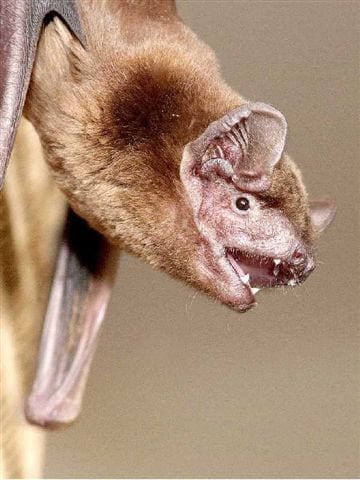Researchers to create device to protect bats from wind turbines
July 28, 2015Wind turbine blades are killing hibernating bats, but researchers may have found a solution to prevent future deaths.
Researchers at the University of Massachusetts and Texas A&M, are working on developing a device that will help to protect migrating bats from being damaged or killed by the blades of wind turbines, a problem that the researchers believe is a major issues for the hibernating bats population, which has already been devastated by a disease known as white-nose syndrome.
A device that could produce an ultrasonic whistle could deter the bats from spinning blades.
The researchers are working on developing a device that would make a pulsing ultrasonic whistle; a sound that would mimic the one made from a bat’s larynx that is used as a deterrent for other bats that come into the area. The idea (and the hope) is that by attaching this device to the wind turbines, the sound will deter bats from the area and keep them safe from the blades.
According to associate professor in environmental conservation, Paul R. Sievert, who is also overseeing the project, once the device is attached to the blades of a wind turbine, “as those blades turn, the air goes through these tiny whistles emitting sounds which basically keep bats away from the spinning blades.”
The bat-based sound technology for wind turbines is still in its first stages.
The researchers are not quite certain just how dangerous the wind blades are to bats, but a significant number of dead bats have been found on wind farms. Sievert said that “We don’t know how serious the issue is,” but added that as more turbines are installed, “It has the potential to be.” The development of this technology is precautionary, more than anything else, but is considered worth the time and expense if it prevents more bats from dying.
The first step of the project, said Sievert, is to design and produce the technology, a process that will be completed by working with Yahya Modarres-Sadeghi, a professor of mechanical and industrial engineering, and students of this department. Once completed, the device will be tested on lab bats to see if the sound actually repels them. This test will be performed by Michael Smotherman from Texas A&M University.
The device will undergo rigorous testing and, if it works out as the researchers expect, they will receive funding for another two-year grant that will enable them to attach the devices to turbine blades.
The devices are not expected to have any effect on the power production of wind turbines.

 With over 15 years of reporting hydrogen news, we are your premier source for the latest updates and insights in hydrogen and renewable energy.
With over 15 years of reporting hydrogen news, we are your premier source for the latest updates and insights in hydrogen and renewable energy.